Dairy Queen Reese’s Peanut Butter Cup Blizzard
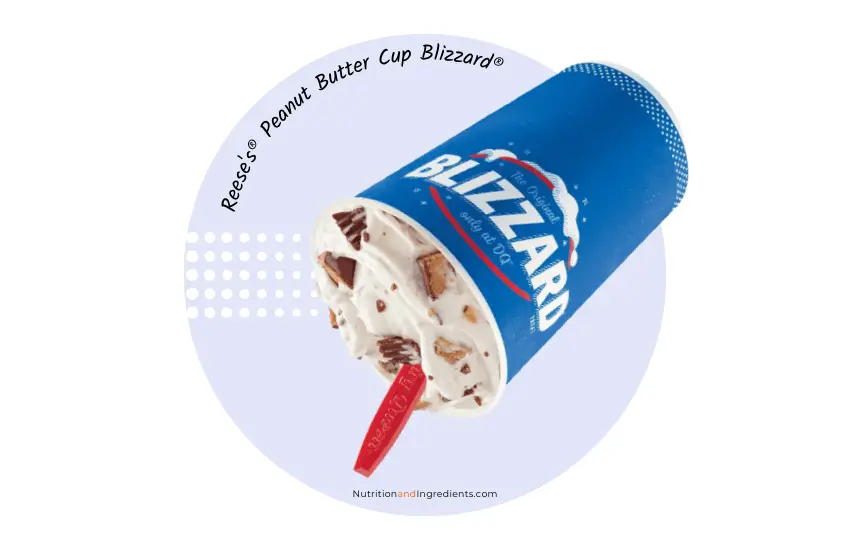
The famous DQ Blizzard is created with thick and creamy vanilla ice cream blended with pieces of Reese’s Peanut Butter Cup candy.
The smallest size available, a Mini Blizzard, contains 360 calories, 14 grams fat, 50 grams carbohydrates, and 9 grams protein.
Read this guide for a complete overview of the nutritional information, ingredients, and allergens, in a DQ Blizzard made with bits of Reese’s Peanut Butter Cup.
Peanut Butter Cup Blizzard Nutrition Facts
Nutritional information is presented based on a single serving measured as one Blizzard treat. The fast food restaurant offers four sizes: Mini, Small, Medium, and Large.
Calories
Calories vary by size ordered. Here is a summary of the total calories based on Peanut Butter Cup Blizzard size.
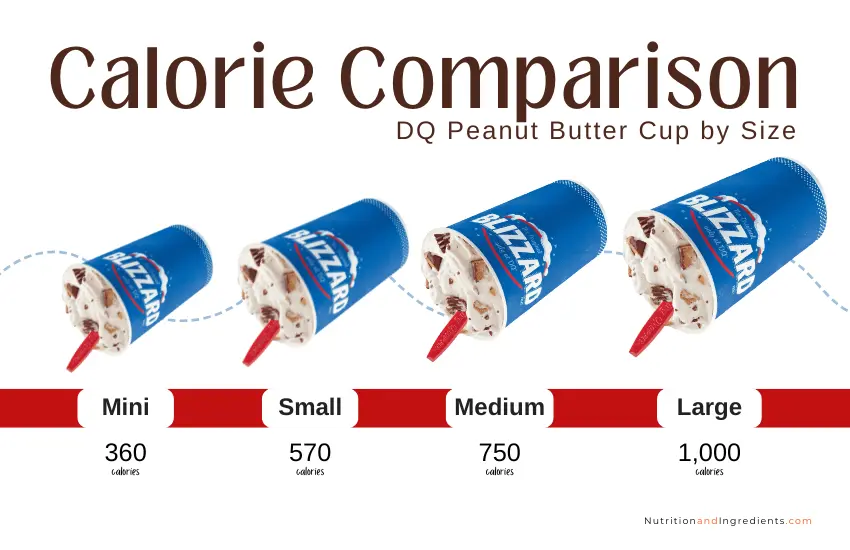
Calories by Macronutrient
Review the table below for calories by macronutrient in the Reese’s PB Cup Blizzard.
Blizzard Calories by Macronutrient by Size
|
Small |
Medium |
Large | |
|---|---|---|---|
|
Calories from Fat |
210 |
280 |
380 |
|
Calories from Carbohydrates |
310 |
400 |
530 |
|
Calories from Protein |
50 |
70 |
90 |
|
Total Calories |
570 |
750 |
1,000 |
More than half of the total calories are derived from carbohydrates. Dietary fat contributes about 36% of the calories and the remaining 8% is from protein.
DQ Peanut Butter Cup Blizzard
% calories from fat, carbs and proteinCalories by macronutrient is a rounded estimate based on standard formulations and nutrition facts provided by Dairy Queen fast food restaurant.
FITNESS TIME TO BURN 750 CALORIES (medium)
Estimate based on moderate level of activity by an adult with average BMI.
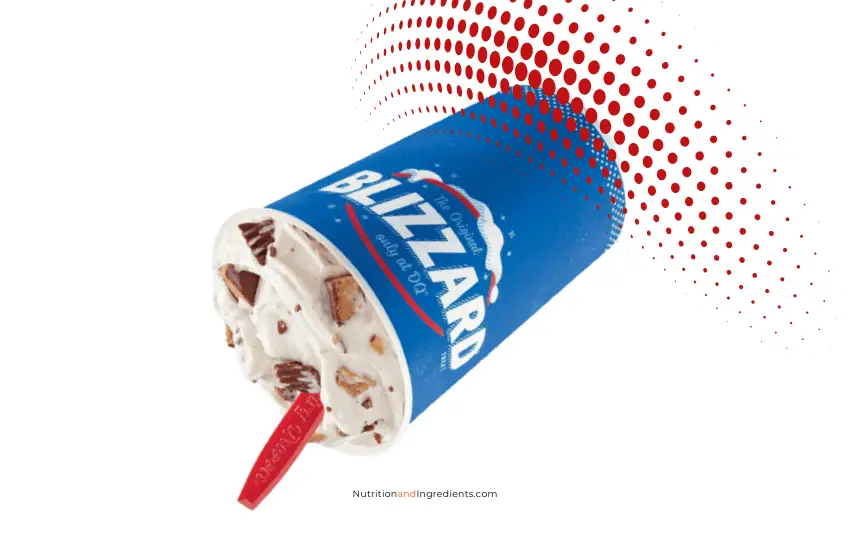
Here is a summary of the nutrition facts for Dairy Queen’s Blizzard made with Reese’s Peanut Butter Cups, by size.
Nutrition Facts
Amount in 1 Blizzard (%DV)
|
SMALL |
MEDIUM |
LARGE | |
|
Calories |
570 |
750 |
1,000 |
|
Total Fat |
23g (29%) |
31g (40%) |
42g (54%) |
|
Saturated Fat |
12g (60%) |
16g (80%) |
21g (105%) |
|
Trans Fat |
0.5g |
1g |
1g |
|
Cholesterol |
45mg (15%) |
60mg (20%) |
80mg (27%) |
|
Sodium |
290mg (13%) |
380mg (17%) |
510mg (22%) |
|
Carbohydrates |
79g (29%) |
102g (37%) |
136g (49%) |
|
Dietary Fiber |
1g (4%) |
2g (7%) |
3g (11%) |
|
Total Sugars |
68g |
88g |
118g |
|
Protein |
15g |
19g |
25g |
%DV based on a 2,000 calorie diet. Calorie needs vary and your %DV may be higher or lower. Provided for informational purposes only. Consult with your physician for dietary or healthcare advice.
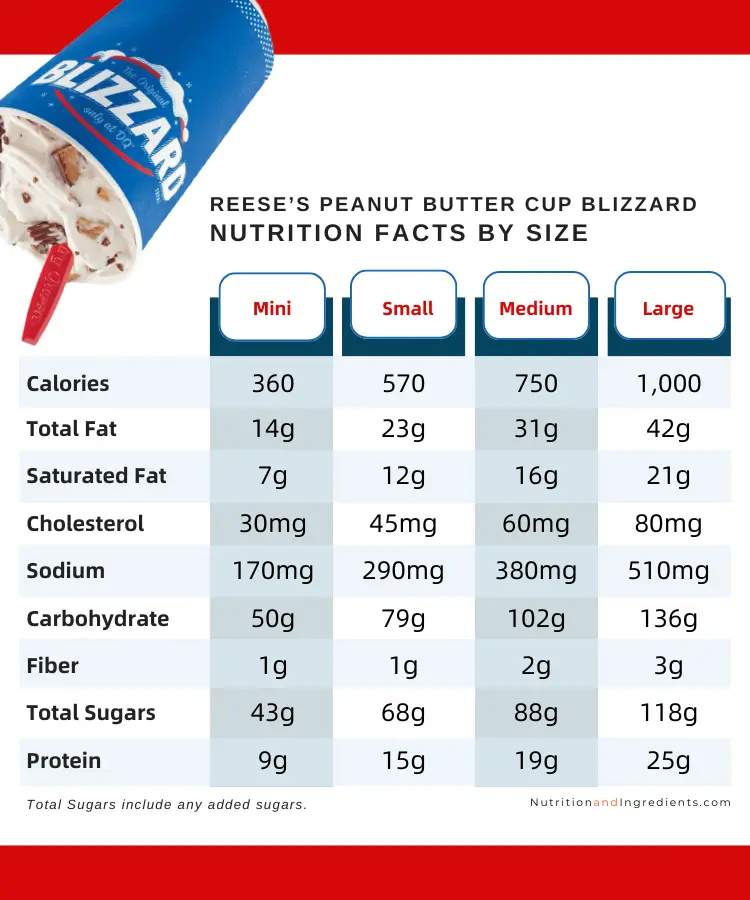
Check the popular DQ chocolate dipped cone and Shake Shack Vanilla Shake nutrition reports.
Compare total sugars and saturated fat to determine if one of the sweet treats is the best option for your diet plan.
Dietary Fats
The amount of saturated fat in a Dairy Queen Blizzard with Peanut Butter Cup candy pieces contains up to 21 grams saturated fat, depending on size. That is high.
Here is a summary of the amount and the daily value of total fat and saturated fat in DQ’s Blizzard, by size.
Amount of Fat (%DV) in Blizzard
|
Small |
Medium |
Large | |
|---|---|---|---|
|
Total Fat |
23g |
31g |
42g |
|
% Daily Value* |
29% |
40% |
54% |
|
Saturated Fat |
12g |
16g |
21g |
|
% Daily Value* |
60% |
80% |
105% |
*Per FDA for average adult American, based on a 2,000 calorie daily diet
The amount of saturated fat in a PB Cup Blizzard is high (for all sizes). A large Blizzard contains more saturated fat than the recommended limit for an entire day.
Check nutrition facts in Dairy Queen menu items.
Sugars
The smallest size PB Cup Blizzard, a Mini, has 43 grams of total sugars, which includes both natural sugars and added sugars.
General recommendations are to limit calories from added sugars to 10% or less of total calories.
Sugar is one of the top ingredients in both the ice cream and the Reese’s Peanut Butter Cups pieces.
Ingredients and Allergens in DQ Blizzard
Here is the list of ingredients in the Reese’s Peanut Butter Cup Blizzard from Dairy Queen.
Ingredients
|
Reduced Fat Vanilla Ice Cream |
|
Milkfat and Nonfat Milk, Sugar, Corn Syrup, Whey, Mono- and Diglycerides, Artificial Flavor, Guar Gum, Polysorbate 80, Carrageenan, Vitamin A Palmitate |
|
Reese’s Peanut Butter Cup Pieces |
|
Milk Chocolate (Sugar, Cocoa Butter, Chocolate, Skim Milk, Milk Fat, Lactose, Lecithin, PGPR), Peanuts, Sugar, Dextrose, Salt, TBHQ, Citric Acid |
Allergens
This sweet treat is made with ingredients that contain milk, peanuts, and soy. It may also contain egg, treenuts, and wheat.
Check full list of allergens in Dairy Queen menu items.

Nutrition facts, prices, and ingredients are based on available information as of the date of publication. Restaurants and food manufacturers may change recipes or formulations without notice. Check package labels and ask the product manufacturer or restaurant for the most up-to-date information. Unless otherwise stated, %DV is based on a 2,000 calorie diet. All reports and reviews published on this site are for informational purposes only. NutritionandIngredients.com does not provide healthcare advice or dietary recommendations. Always consult your licensed physician for any healthcare or dietary advice.
Nutrition facts, allergens, and ingredients source: Dairy Queen. Blizzard images courtesy of Dairy Queen. Original designs created by Nutrition & Ingredients for research and commentary related to fast food reviews.
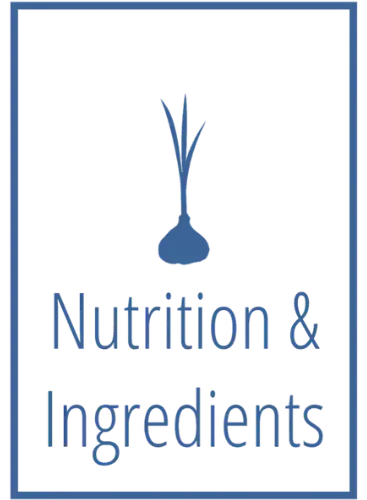
So much sugar! I shouldn’t be surprised. But I am. You note added sugars in many of the other products. How many added sugars in this blizzard?
Patrick,
Unfortunately DQ doesn’t provide a breakout of the added sugars vs natural sugars. But, there are data that points to total sugars being comprised of nearly all added sugars. Added sugars are about 90% of total carbs in Reese’s PB Cups. There’s only 1g fiber in a small Blizzard. Sugar and Corn Syrup are top 3 ingredients in the ice cream. So while there is natural sugar in milkfat, I would guess added sugars make up 80-90% of the total sugars.
Thanks for your comments!
– Isabel